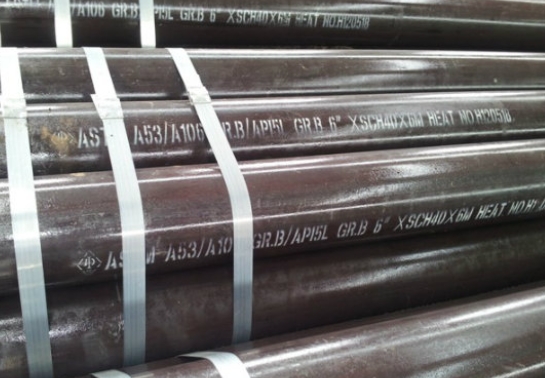
ASTM A53 Seamless Steel Pipe
What is ASTM A53?
The ASTM A53 standard is a standard specification for welded and seamless carbon steel pipes developed by the American Society for Testing and Materials (ASTM). ASTM A53 is widely used in construction, plumbing, and mechanical applications for conveying water, gas, steam, and other liquids.
What is ASTM A53 Seamless Steel Pipe?
ASTM A53 Seamless Steel Pipe is a type of steel pipe that is manufactured without a welded seam, in accordance with the ASTM A53 specification. This specification covers seamless and welded black and hot-dipped galvanized steel pipe in NPS (Nominal Pipe Size) 1/8 to NPS 26. The pipes are designed for mechanical and pressure applications, and are also suitable for use in steam, water, gas, and air lines.

Grades, types, size range
1. Grades:
Grade A and Grade B, with Grade B being the most common.
2. Types:
Type S: Seamless
Type E: Electric-resistance-welded
Type F: Furnace-welded
3. Size Range:
NPS 1/8 to NPS 26 (Nominal Pipe Size) for nominal (average) wall thicknesses.
Mechanical Properties:
Tensile Strength: Minimum of 60,000 psi for Grade B
Yield Strength: Minimum of 35,000 psi for Grade B
Elongation: Varies based on pipe diameter and wall thickness.
Testing and Inspection:
Pipes are subjected to various mechanical tests like bending, flattening, and hydrostatic testing to ensure they meet the standards.
ASTM A53 Seamless Steel Pipe VS ASTM A53 Welded Steel Pipe
1. Manufacturing Process:
Seamless Steel Pipe (Type S):
Production Method: Made by piercing a solid billet and then drawing it to the desired size and thickness. The pipe is created without a welded seam, making it more uniform in structure.
Key Feature: No welded seam, which can eliminate the risk of seam failure under pressure.
Welded Steel Pipe (Type E and Type F):
Type E (Electric-Resistance-Welded): Produced by cold-forming a flat steel strip into a cylindrical shape and then welding the edges together using electric resistance welding.
Type F (Furnace-Welded): Less common, involves heating the edges to be joined and then applying pressure to weld them together.
Key Feature: Has a visible seam, which can be a point of weakness under certain conditions.
2. strength and performance
Seamless Pipe:
Strength: Generally stronger due to the absence of a seam. The uniformity of the structure makes it better suited for high-pressure applications. Durability: Better resistance to pressure and mechanical stress.
Welded Pipe:
Strength: Slightly lower strength compared to seamless pipes, especially at the welded seam. However, modern welding techniques have minimized the difference in performance. Durability: Adequate for most applications, though the seam can be a point of potential failure under extreme conditions.
3. Cost:
Seamless Pipe:
Cost: Typically more expensive due to the more complex manufacturing process and the higher performance characteristics.
Welded Pipe:
Cost: Generally less expensive, as the production process is simpler and more cost-effective.
4. Applications:
Seamless Pipe:
Applications: Ideal for high-pressure environments like oil and gas transportation, boilers, and heat exchangers. Also used in mechanical and structural applications where strength is critical.
Welded Pipe:
Applications: Suitable for lower pressure applications such as water and gas lines, general plumbing, and construction. Common in applications where the pipe is not subjected to extreme pressures or stresses.
Read more: ASTM A53 Welded Steel Pipe


